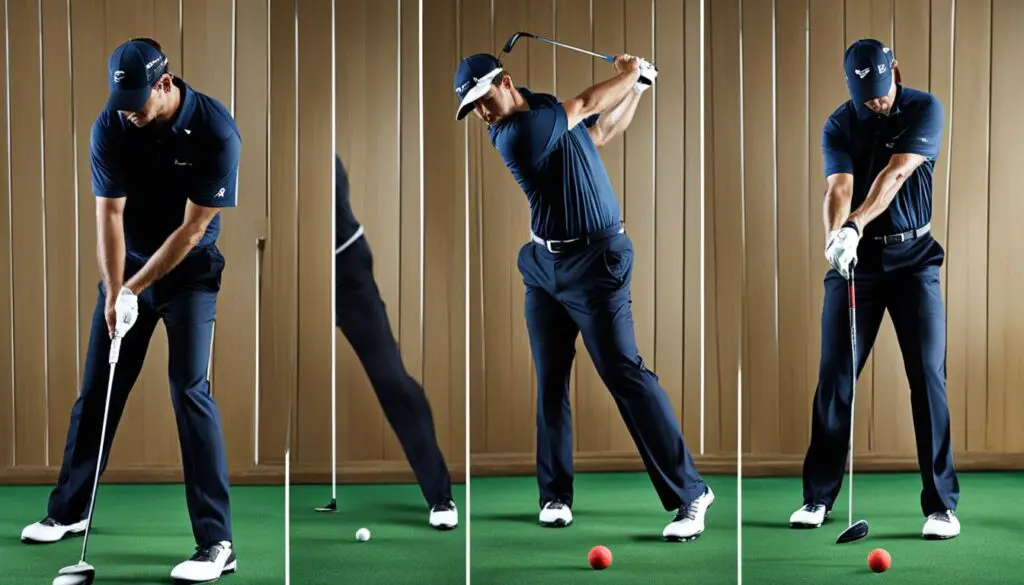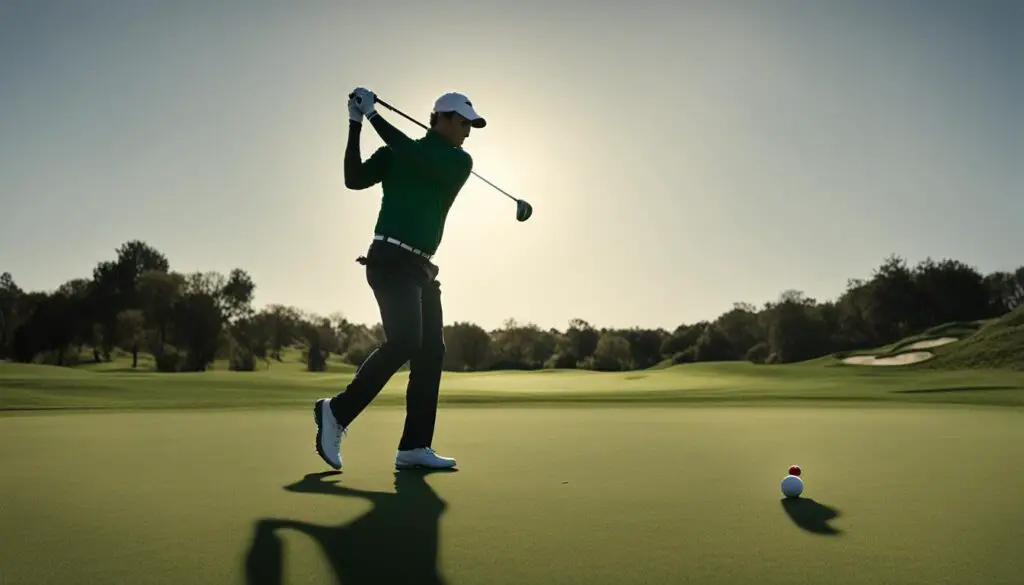Welcome to our comprehensive guide on mastering the art of swinging a golf club. Whether you’re a beginner or an experienced golfer looking to improve your swing, this article will provide you with the essential techniques and fundamentals to help you achieve optimal results on the course. From the correct setup to the execution of the swing, we’ll walk you through each step to ensure you develop a solid and effective golf swing.
Key Takeaways:
- Start with the correct setup, with your front foot slightly ahead of the ball and your feet wider than shoulder-width apart.
- Maintain a proper spine angle by positioning your hands about a fist or a fist and a half away from your thighs.
- Check your alignment by placing a golf club along the tips of your toes and ensure it is pointing towards your target.
- Bend your knees slightly and distribute your weight evenly on both feet.
- Position yourself close enough to the ball to maintain a relaxed and balanced posture throughout your swing.
Getting Close to the Ball
When it comes to perfecting your golf swing, one important aspect to consider is getting close to the ball. Positioning yourself at the right distance from the ball is crucial to ensure that your swing is accurate and powerful. Standing too close or too far away can negatively affect your posture, balance, and overall swing technique.
Find a comfortable distance that allows the middle of the club face to reach the ball with your arms outstretched but still relaxed. This position will enable you to maintain the correct posture throughout your swing. Your upper body should be slightly bent toward the ball, while your torso is bent away from the target. This setup promotes a stable and balanced stance that allows for a smooth and controlled swing.
Remember, consistency in your swing technique is key to improving your golf game. Take the time to practice and fine-tune your positioning until you find the optimal distance from the ball that works best for you.
Key points:
- Position yourself at the right distance from the ball for an accurate and powerful swing.
- Avoid standing too close or too far away; find a comfortable distance that allows for a balanced stance.
- Maintain the correct posture with a slight upper body bend toward the ball and a torso bend away from the target.
- Consistency in your swing technique is crucial for improvement; practice and fine-tune your positioning.
Perfecting Your Grip
The grip is one of the most fundamental aspects of a proper golf swing. It directly affects how the clubface interacts with the ball and ultimately determines the accuracy and power of your shot. Mastering your grip is crucial for achieving consistent results on the course.
Start by holding the club with a relaxed grip, allowing the clubhead to turn over naturally during your swing. There are different types of grips to experiment with, such as the baseball grip, overlap grip, and interlocking grip. Find the grip that feels most comfortable and allows you to maintain control throughout your swing.
Remember to hold the club with the right amount of pressure – not too tight and not too loose. A grip that is too tight can restrict the natural movement of your wrists and arms, leading to a stiff and ineffective swing. On the other hand, a grip that is too loose can result in loss of control and consistency. Strive for a grip that provides a firm hold without tension.
Proper Grip Checklist:
- Relaxed grip that allows for natural clubhead movement
- Experiment with different grip types to find the most comfortable one
- Hold the club with the right amount of pressure – firm but not too tight
“The grip is the foundation of your swing. It’s important to find a grip that feels comfortable and allows you to maintain control throughout your swing.” – Golf Pro
Perfecting your grip is a continuous process that requires practice and experimentation. As you develop your swing, pay close attention to how your grip affects the flight and accuracy of your shots. By finding the right grip for you and maintaining a consistent grip pressure, you’ll be well on your way to mastering the art of the golf swing.
Mastering the Backswing
Mastering the backswing is a crucial part of developing a solid golf swing. It sets the foundation for a powerful and accurate shot. By understanding the key elements and practicing proper technique, you can take your game to the next level. In this section, we will explore the fundamentals of the backswing and offer some valuable drills to help you improve.
Key Fundamentals
When it comes to the backswing, there are a few key fundamentals that you need to keep in mind. First, focus on maintaining a connected and synchronized movement between your arms and body. This will help you achieve a smooth and consistent swing. Secondly, pay attention to your wrist position. It’s important to let your wrist hinge naturally during the backswing, allowing the club to reach its highest point at the top of the swing. Lastly, maintain a straight front arm and rotate your torso to generate power and create a coil.
Drills for Improvement
Practice makes perfect, and incorporating specific drills into your training routine can help you master the backswing. One effective drill is the “One-Arm Backswing Drill.” Start by gripping the club with only your lead hand (left hand for right-handed golfers) and take practice swings, focusing on a smooth and controlled backswing. This drill helps you develop a better feel for the movement and promotes better sequencing between your body and arms. Another useful drill is the “Pause-and-Check Drill.” During your backswing, pause at the top and check your positions—proper wrist hinge, straight front arm, and a coiled torso. This drill enhances your awareness and helps you refine your technique.
Remember, a strong and consistent backswing is the foundation for a great golf swing. Take the time to practice and focus on the key fundamentals. With dedication and the right drills, you can achieve mastery in your backswing and improve your overall golf game.

Next, we will delve into the critical aspects of executing the downswing, where you unleash the power and accuracy of your swing. Stay tuned to learn more about perfecting your downswing.
Executing the Downswing
Once you’ve mastered the backswing, it’s time to focus on executing the downswing. This phase of the golf swing is where you start to unwind and bring the club back down towards the ball. It’s an essential part of the swing that requires precision and proper mechanics to achieve consistent and powerful shots.
One crucial element of the downswing is shifting your weight from the ball of your back foot to the ball of your front foot. This weight transfer allows you to generate power and maintain balance throughout your swing. As you shift your weight, focus on unwinding your body and allowing your arms to naturally follow through the impact area. This combination of body rotation and arm movement will help you achieve a smooth and powerful downswing.
Another key aspect of the downswing is ensuring that the shaft of the club is leaning forward toward the target at the moment of impact. This forward shaft lean creates the proper angle of attack and promotes solid contact with the ball. Additionally, using your hips to generate power in your swing can further enhance the effectiveness of your downswing.
Quick tips:
- Shift your weight from the back foot to the front foot during the downswing.
- Unwind your body and allow your arms to naturally follow through the impact area.
- Maintain a forward shaft lean at the moment of impact for solid contact with the ball.
- Utilize your hips to generate power in your swing.
Remember, executing the downswing correctly is crucial for achieving distance and accuracy in your shots. Practice your downswing mechanics regularly and focus on maintaining a balanced and controlled swing. With consistency and dedication, you can improve your golf swing and enjoy more success on the course.
Finishing Strong
When it comes to mastering the art of the golf swing, finishing strong is just as important as starting strong. A strong finish ensures that you maintain good form and technique throughout your swing, resulting in accurate shots and optimal distance. Here are some golf swing tips to help you finish strong:
- Keep your eyes on the ball: Throughout your swing, it’s crucial to keep your eyes focused on the ball. This will help you maintain proper alignment and ensure a solid strike.
- Maintain a balanced follow-through position: After making contact with the ball, continue your swing with a smooth follow-through. Your belt buckle should be facing the target, and the club should have swung through to a position somewhat behind you. This balanced finish will help promote accuracy and prevent any unnecessary strain on your body.
- Avoid excessive power: While it may be tempting to try and hit the ball with all your strength, it’s important to focus on maintaining good form and technique. Excessive power can lead to inconsistencies and loss of control. Instead, focus on a smooth and controlled swing that allows you to maintain your balance throughout.
By incorporating these golf swing tips into your game, you’ll be able to finish strong and achieve more consistent and accurate shots. Remember, practice makes perfect, so be sure to spend time honing your skills on the golf course or at the driving range.
Golf Swing Analysis
An essential part of improving your golf swing is analyzing your technique. A golf swing analysis can provide valuable insights into areas where you can make adjustments to enhance your performance. Here are a few key benefits of a golf swing analysis:
- Identifying swing flaws: A swing analysis can help identify any flaws or inconsistencies in your swing mechanics. By pinpointing these areas, you can work on correcting them to improve your overall swing.
- Highlighting areas of improvement: The analysis can also highlight specific areas where you can make improvements. Whether it’s adjusting your grip, optimizing your body alignment, or fine-tuning your swing path, these insights can help you focus your practice sessions and make targeted improvements.
- Tracking progress: Regular swing analysis allows you to track your progress over time. By comparing your swing at different intervals, you can see how your adjustments are impacting your performance and make necessary tweaks along the way.
To get the most out of a golf swing analysis, consider consulting with a golf instructor or using swing analysis software or apps. These resources can provide you with valuable feedback and guidance as you work towards refining your swing and achieving your golfing goals.

Correcting the Slice
If you find yourself consistently hitting a slice in your golf swing, don’t worry – it’s a common problem that can be corrected with the right adjustments. One key aspect to check is your knee position during the swing. By ensuring that your knees are properly bent throughout the swing, you can prevent the ball from curving uncontrollably.
To correct a slice, focus on maintaining a slight flex in your knees throughout the swing. This helps to stabilize your lower body and promotes a more controlled and accurate swing path. Be mindful of any excessive straightening or locking of your knees, as this can contribute to an open clubface at impact and lead to a slice.
During your swing, pay attention to the feeling of maintaining a consistent bend in your knees. You can also incorporate specific drills into your practice routine to reinforce this correct knee position. One effective drill is to practice hitting shots while keeping a towel or object wedged between your knees. This encourages a stable and controlled lower body, helping to prevent the slice.
Building a Proper Golf Grip
When it comes to mastering your golf swing, one of the fundamental elements you need to focus on is your grip. A proper golf grip is the foundation for a consistent and powerful swing. It allows you to control the clubface and generate maximum clubhead speed. Here are some golf grip techniques and fundamentals to help you build a solid grip:
- Choose the Right Grip Style: There are different grip styles to choose from, including the overlapping grip, interlocking grip, and the baseball grip. Experiment with each grip to find the one that feels most comfortable and secure in your hands. Remember to maintain a relaxed grip pressure.
- Create Connection: To create a strong and connected grip, start by placing the club in your left hand (for right-handed golfers) and then interlock or overlap your right hand with the left hand. The goal is to create a unified grip where the hands work together as one unit.
- Position the Hands: The position of your hands in the grip is crucial for a consistent swing. Keep your hands slightly ahead of the clubface, ensuring that the “V” formed by your thumb and index finger points towards your right shoulder (for right-handed golfers). This helps to ensure the clubface is square at impact.
- Avoid Gripping Too Tightly: Many golfers make the mistake of gripping the club too tightly. This can lead to tension in your swing and result in less control and power. Instead, maintain a firm but relaxed grip, allowing for a smooth and fluid swing.
By building a proper golf grip, you set yourself up for success in your swing. It provides the stability and control you need to consistently strike the ball with accuracy and power. So take the time to practice and refine your grip technique, and watch as your golf game improves.
Tips for Maintaining a Proper Golf Grip
- Regularly check your grip: Over time, your grip can become loose or slip out of position. Take a moment to check your grip before each round or practice session to ensure it is still secure and in the correct position.
- Practice with different grip sizes: Golf grips come in different sizes, ranging from undersize to oversize. Experiment with different grip sizes to find one that feels comfortable and allows you to have a relaxed and controlled grip throughout your swing.
- Warm up your hands: Before gripping the club, warm up your hands to improve blood flow and increase flexibility. This can help you maintain a more relaxed grip and reduce the risk of tension in your swing.
- Seek professional advice: If you’re struggling with your grip or want to refine your technique, consider seeking guidance from a golf professional. They can assess your grip and provide personalized tips and adjustments to help improve your swing.
Mastering Your Golf Posture
Proper golf posture is essential for a successful swing. By adopting the right posture, you can optimize your body’s alignment, stability, and flexibility, leading to improved swing mechanics and overall performance on the course. Here are some golf posture tips to help you refine your technique:
- Stand with a slight forward tilt at the hips and keep your knees flexed. This athletic position promotes balance and allows for a more dynamic swing.
- Relax your arms and let them hang naturally down to your sides. Tension in your arms can restrict your range of motion and hinder your swing.
- Maintain a comfortable and relaxed posture throughout your swing. Avoid excessive stiffness or slouching, as this can negatively impact your swing mechanics.
A good golf posture enables you to execute your swing with precision and power. It facilitates proper weight transfer, allows for a full extension of your arms, and promotes a more efficient transfer of energy from your body to the club. Remember, consistency is key when it comes to your golf posture, so practice and reinforce proper technique to develop muscle memory and optimize your performance.
“A proper golf posture sets the foundation for a successful swing. It allows you to maintain balance, control, and power throughout your swing, ultimately leading to better ball striking and increased distance.”

Achieve Optimal Performance with Proper Golf Posture
Golf posture is a fundamental aspect of your swing that often goes overlooked. By incorporating these golf posture tips into your routine and practice, you can take your game to the next level. Remember to maintain a slight forward tilt at the hips, keep your knees flexed, and let your arms hang naturally. With consistent practice, you’ll develop a strong and reliable posture, leading to better control, accuracy, and distance in your shots.
Aligning Your Body
Proper alignment is an essential element of a successful golf swing. By aligning your body correctly, you can improve accuracy and consistency in your shots. To achieve proper alignment, start by ensuring that your feet and shoulders are parallel to your target line. Visualize an imaginary line passing from your back shoulder to front shoulder and from your back foot to front foot, all pointing directly at your target. This alignment will help you maintain accuracy throughout your swing.
Additionally, it is important to adopt the correct posture when aligning your body. Lean your upper body slightly forward at the hips and keep your knees slightly bent. This athletic position will provide stability and flexibility during your swing. Make sure your shoulders are aligned with your feet, aiming directly at the target line. By maintaining good body alignment, you’ll have a solid foundation for a successful swing.
Golf Alignment Techniques:
- Align your feet and shoulders parallel to your target line.
- Visualize an imaginary line from your back shoulder to front shoulder and from your back foot to front foot, pointing at the target.
- Lean your upper body slightly forward at the hips and keep your knees slightly bent.
- Ensure your shoulders are aligned with your feet, aiming at the target line.
“Proper alignment is the key to accurate shots in golf. By aligning your body correctly and maintaining good posture, you’ll set yourself up for success in each swing.” – Golf Pro
Positioning the Ball
Proper ball position is a fundamental element of a successful golf swing. The position of the ball will vary depending on which club you’re using. For longer clubs like the driver, the ball should be positioned near your front foot. This allows you to catch the ball on the upswing, maximizing distance. As you move to shorter clubs, the ball should be moved back to the center of your stance. This helps ensure solid contact and control.
It’s important to experiment and find the ball position that works best for you. Pay attention to your swing and the results you’re getting. If you tend to hit the ball with too much fade or slice, try moving the ball slightly forward in your stance. Conversely, if you tend to hook the ball, try moving it slightly back. Small adjustments to the ball position can have a big impact on the outcome of your shots.
Remember to maintain good posture and alignment when positioning the ball. Stand with your feet shoulder-width apart and your weight evenly distributed. Keep your spine straight and your eyes focused on the ball. These fundamentals will help ensure a solid foundation for your swing.

The Importance of Ball Position for Accuracy
Ball position plays a crucial role in the accuracy of your shots. Placing the ball correctly in relation to your stance and target line can help you achieve the desired trajectory and ball flight. When the ball is aligned correctly, you can more easily strike it with the center of the clubface, resulting in more consistent and accurate shots.
“The correct ball position is like the key to a lock. It unlocks the potential of your swing and allows you to hit the ball with precision and control.” – Golf Pro
Keep in mind that ball position is not a one-size-fits-all concept. It can vary depending on your swing style, club selection, and the shot you’re attempting. Experimenting with different ball positions during practice sessions will help you understand how each adjustment affects your ball flight and overall performance.
- For longer clubs, such as the driver and fairway woods, position the ball just inside your front heel. This promotes an upward strike and helps maximize distance.
- With mid-irons and short irons, place the ball in the center of your stance. This allows for a more neutral strike and better control.
- For shots that require a lower trajectory, such as punch shots or shots into the wind, move the ball back in your stance. This de-lofts the clubface and promotes a lower, more penetrating ball flight.
By understanding proper ball position and making adjustments based on your swing and shot requirements, you’ll be able to consistently deliver accurate and powerful shots on the golf course.
Understanding Golf Swing Planes
The golf swing plane is a crucial concept to understand in order to improve your swing mechanics. The swing plane refers to the angle and path that your club follows as it moves through your swing. Having a solid understanding of swing planes can help you achieve more consistent and accurate shots on the golf course.
Types of Swing Planes
There are two main types of swing planes: the one-plane swing and the two-plane swing. The one-plane swing is characterized by a shallower swing path, with the club moving around the body on a flatter plane. This type of swing is often associated with players like Ben Hogan and Matt Kuchar, who have a more compact and efficient swing motion.
The two-plane swing, on the other hand, has a steeper swing path, with a more upright backswing and a flatter downswing. This type of swing is often associated with players like Tiger Woods and Rory McIlroy, who generate a lot of power and clubhead speed through their swing motion.
Importance of Swing Plane
Having a proper swing plane is important for several reasons. First, it helps to promote a more consistent swing path, which leads to more accurate shots. When your club follows a consistent plane, you are more likely to make solid contact with the ball and achieve the desired trajectory.
Secondly, a proper swing plane helps to maximize power and distance. By having a shallow or steep swing path that matches your body type and swing style, you can generate more leverage and clubhead speed, resulting in longer shots off the tee and fairway.
Finally, understanding swing planes can help you diagnose and correct swing faults. By analyzing your swing path and comparing it to the ideal plane for your swing style, you can identify areas that need improvement and make the necessary adjustments to enhance your overall swing mechanics.
Achieving Good Body Alignment
Good body alignment is crucial for accurate shots in golf. When setting up for a shot, it’s important to ensure that your body is aligned parallel to the target line. Start by positioning your feet, hips, and shoulders in line with the target. This alignment will help you establish a consistent swing path and improve your accuracy.
Additionally, it’s important to maintain a slight forward tilt at the hips and keep your knees slightly bent. This helps you stay balanced and athletic throughout your swing, allowing for a more natural and fluid motion. A relaxed posture with your arms hanging naturally will also contribute to better body alignment and a more efficient swing.
Remember, body alignment is not only important at setup but throughout your entire swing. Focus on maintaining good alignment from start to finish, ensuring that your shoulders, hips, and feet remain parallel to the target line. This will help you consistently strike the ball with accuracy and achieve better overall performance in your golf game.
Understanding the Backswing
The backswing is a crucial component of a proper golf swing. It sets the foundation for a powerful and accurate shot. To execute a successful backswing, there are a few key techniques to keep in mind.
First, focus on maintaining width in your arms as you take the club back. Keep your hands in line with your back leg and rotate your body smoothly. This will help you create a wide swing arc and generate more clubhead speed.
Next, allow your wrists to hinge naturally during the backswing. This will give you the necessary flexibility and coil in your swing. It’s important to avoid forcing the wrists to hinge or trying to keep them too rigid.
Throughout the backswing, maintain your balance and keep your eye on the ball. This will help you stay connected to the swing and ensure proper timing and rhythm. Remember, the backswing is a preparation for the downswing, so it’s important to stay relaxed and in control.

Tips for a successful backswing:
- Maintain width in your arms by keeping your hands in line with your back leg.
- Allow your wrists to hinge naturally, avoiding any forced movements.
- Stay balanced and keep your eye on the ball throughout the backswing.
- Focus on a smooth and controlled rotation of your body.
Success in the backswing sets the stage for a powerful and accurate downswing. By mastering the techniques and maintaining a good balance and rhythm, you’ll be well on your way to improving your overall golf swing.
Mastering the Transition and Downswing
After achieving a strong backswing, the transition and downswing are crucial for unleashing power and accuracy in your golf swing. The transition is the seamless shift from the top of your backswing to the initiation of the downswing. It’s essential to maintain a smooth transition, allowing your body and hips to unwind naturally while keeping your rhythm intact.
As you initiate the downswing, focus on the synchronization between your arms and body. This synchronization is key to generating maximum power and control in your swing. Remember to keep your arms close to your body and let them naturally follow the rotation of your torso towards the target.
Throughout the downswing, maintain a balanced and controlled motion to optimize impact. Shift your weight smoothly from your back foot to your front foot, while keeping your eyes fixed on the ball. Imagine the clubhead moving on an inside-out path, allowing for a square clubface and a powerful strike.
Key Tips for Improving Your Downswing:
- Focus on a smooth transition from the top of your backswing to the downswing, maintaining rhythm and tempo.
- Synchronize your arms with your body rotation, ensuring a connected and powerful swing.
- Shift your weight smoothly from your back foot to your front foot, generating power and stability.
- Keep your eyes on the ball and visualize an inside-out swing path for a square clubface at impact.

A well-mastered transition and downswing can significantly improve your golf swing by enhancing your distance, accuracy, and consistency. Practice these techniques diligently, and soon you’ll witness the positive impact on your overall game.
Developing a Strong Follow Through
A proper golf swing requires a strong follow through to ensure a solid strike and improve balance and control. Here are some essential tips to help you develop a powerful follow through:
1. Rotate Your Body Towards the Target
As you complete your swing, focus on rotating your body towards the target. This rotational movement helps transfer power from your upper body to the clubhead, resulting in a more powerful shot. Let your hips lead the rotation while keeping your upper body relaxed and aligned with the target.
2. Extend Your Arms Naturally
During the follow through, allow your arms to extend naturally towards the target. This extension helps maintain the momentum of your swing and ensures that the clubhead continues on the desired path. Avoid forcing the extension or holding back too early, as it may result in a weakened swing and decreased accuracy.
3. Maintain a Balanced Finish
As you complete your swing, strive to maintain a balanced finish. Shift your weight onto your front foot and hold your position until the ball lands. This balanced finish helps promote a solid strike and enhances your overall control. Challenge yourself by extending the duration of your finish until the ball stops rolling, further improving your balance and control.
By incorporating these golf swing tips into your practice sessions, you can develop a strong follow through that enhances your swing power, accuracy, and overall performance on the course. Regular analysis of your swing mechanics can also provide valuable insights and help fine-tune your technique for better results.
FAQ
What is the correct setup for a golf swing?
To start, place your front foot slightly ahead of the ball and position your feet wider than shoulder-width apart. Ensure that your hands are hanging about a fist or a fist and a half away from your thighs to maintain a proper spine angle. Check your alignment by placing a golf club along the tips of your toes and make sure it is pointing towards your target. Finally, bend your knees slightly and distribute your weight evenly on both feet, balancing it on the balls of your feet.
How should I position myself close to the ball for a golf swing?
Position yourself close enough to the ball so that the middle of the club face reaches the ball with your arms outstretched but still relaxed. Avoid standing too close or too far away from the ball. Find a comfortable distance that allows your upper body to be slightly bent toward the ball and your torso bent away from the target. This will help you maintain the correct posture throughout your swing.
What is the correct grip for a golf swing?
The grip is crucial for a proper golf swing. Start by holding the club with a relaxed grip, allowing the club head to turn over when you swing. Experiment with different grips, including the baseball grip, the overlap grip, and the interlocking grip, to find one that feels comfortable and allows you to maintain control of the club throughout your swing. Remember to hold the club with the right amount of pressure, not too tight and not too loose.
What should I focus on during the backswing of a golf swing?
During the backswing, start by moving your hands straight back while keeping them close to your back leg. Rotate your torso and maintain a straight front arm. As you continue your backswing, let your wrist break slightly and ensure that the club is perpendicular to your left arm (for right-handed golfers). At the top of your backswing, rotate your torso even further and bend your front arm slightly.
How do I execute the downswing in a golf swing?
Start the downswing by shifting your weight from the ball of your back foot to the ball of your front foot. Unwind your body and allow your arms to follow through the impact area. Make sure to have the shaft leaning forward toward the target at the moment of impact and use your hips to generate power in your swing. Remember to follow through completely and maintain your balance.
How can I finish strong in a golf swing?
A strong finish is essential for a proper golf swing. Keep your eyes on the ball throughout your swing and maintain a balanced follow-through position. Your belt buckle should be facing the target, and the club should have swung through to a position somewhat behind you. Hold this finish as you watch the ball fly off into the distance. Avoid trying to hit the ball with all your strength and focus on maintaining good form and technique.
How can I correct a slice in my golf swing?
If you tend to hit a slice, where the ball curves from left to right (for right-handed golfers), it is important to check your knee position. Ensure that your knees are properly bent during your swing to prevent the ball from curving. This adjustment can help you achieve a more desired ball flight.
What is the foundation of a good golf swing?
The grip is the foundation of a good golf swing. Start by creating a connection between your upper and lower hand, either with an overlapping grip or an interlocking grip. Experiment with different grip sizes to find one that feels comfortable for you. The correct grip will help you square the club face to the ball and prevent excessive tension in your swing.
How should I position my body for a proper golf swing?
Your golf posture plays a crucial role in your swing. Adopt an athletic position with a slight forward tilt at the hips and bent knees. Keep your arms relaxed and let them naturally hang down to your sides. Maintain a comfortable and relaxed posture that allows for flexibility and movement during your swing.
How important is alignment in a golf swing?
Proper alignment is essential for accurate shots. Ensure that your feet and shoulders are aligned parallel to your target line. Visualize an imaginary line passing from your back shoulder to front shoulder and from your back foot to front foot, all pointed directly at your target. This will help you maintain accurate alignment throughout your swing.
Where should I position the ball for different clubs?
The position of the ball depends on which club you are using. For longer clubs like the driver, the ball should be positioned near your front foot. As you move to shorter clubs, the ball should be moved back to the center of your stance. Adjust the ball position to achieve optimal impact and launch conditions for each club.
What are the different types of golf swing planes?
The golf swing plane refers to the angle and path created by your club as it moves through your swing. There are two main types of swing planes, the one-plane swing and the two-plane swing. The one-plane swing is simpler and involves a more shallow swing path, while the two-plane swing is steeper and involves a more upright backswing and flatter downswing.
How important is body alignment in a golf swing?
Good body alignment is crucial for accurate shots. Make sure your body is aligned parallel to your target line. Let your upper body tilt forward at the hips and keep your knees slightly bent. Your shoulders should match the alignment of your feet, aiming at the target line. Maintain good body alignment throughout your swing to promote accuracy.
What should I focus on during the backswing of a golf swing?
The backswing is the initial phase of your swing where you raise the club away from the target. Start by taking the hands back in a straight line while rotating the body. Maintain width in the arms and let the wrists hinge naturally. The backswing should result in a coiled position with the club pointing towards the target line.
How can I master the transition and downswing in my golf swing?
The transition and downswing are crucial for generating power and accuracy in your swing. Transition smoothly from the top of your backswing, allowing your body to unwind and your hips to rotate towards the target. Maintain good timing and rhythm as you initiate the downswing, ensuring that your arms and body work together in sequence. Focus on achieving a balanced and controlled downswing for optimal impact.
How important is the follow through in a golf swing?
A strong follow through is a key component of a proper golf swing. Rotate your body towards the target and let your arms extend naturally. Maintain a balanced finish with most of your weight on your front foot. Hold this position until the ball lands to ensure a solid strike. Additionally, challenge yourself to hold your finish until the ball stops rolling to improve balance and control.
